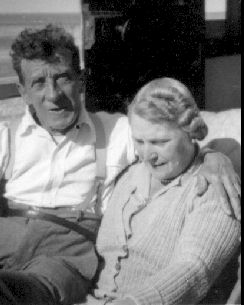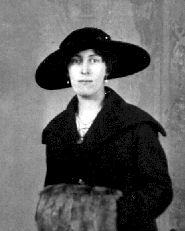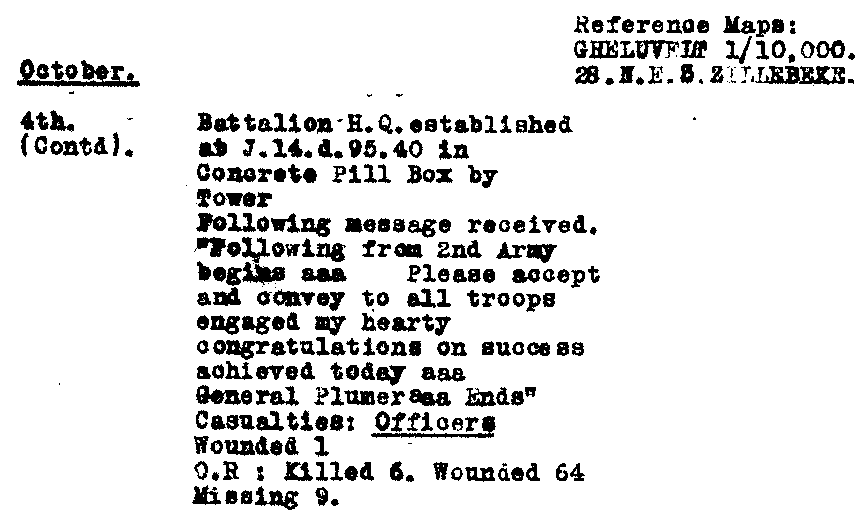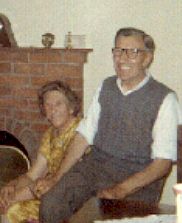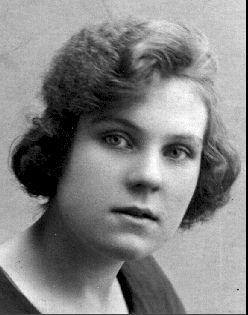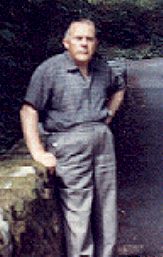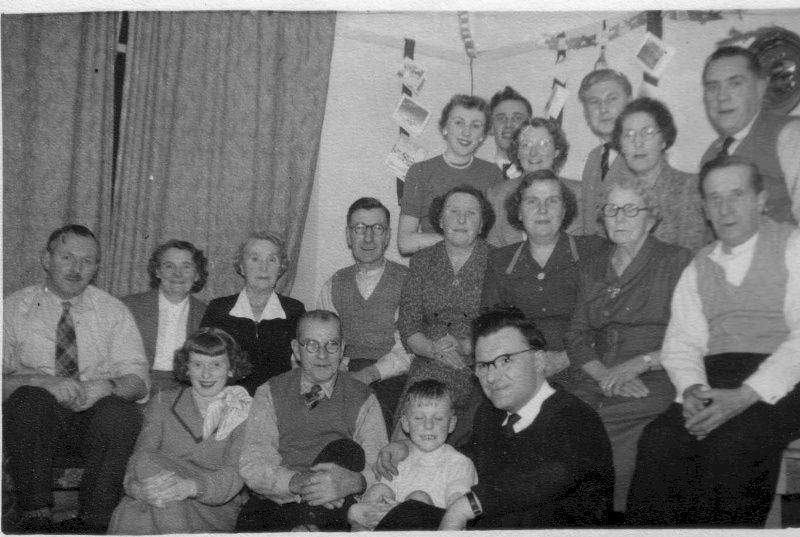.
Noon Family - via George Henry Line
Note 1 - Thomas Noon was born in Ireland in 1804 and worked in England as a plasterer. He married Sarah Rayner (1805) from Chelmsford in Essex in 1830 Note 2 - Frederick (snr) worked as a Grocers packer and married Mary (born 1839 - maiden name not known) in September 1860 in the parish of St George Southwark Note 2 - There is a possibility that William fathered an illegitimate son sometime around March 1917 prior to being sent to France.
|
|||||||||||||||||||||||||||||||||||||||||||||||||||||||||||||||||||||||||
| Frederick Noon (1865 - 1945) and Mary Noon (1866 - 1944) By trade he was a surgical instrument case maker. His wife Mary took in laundry. From 1901 they lived at 51 Deacon Street, Newington, in South London with daughters Sarah, Ada, and Susannah and sons William and Thomas. By the outbreak of the First World War they had moved to 62 Cronin Road near the Old Kent Road, by which time the family had increased with the births of Amelia and Frederick jnr. It is believed there were other children who either died in infancy or who were stillborn. Between wars they moved to the new LCC housing estate at Bellingham. The photograph shows them in the garden of this house with son and daughter Fred and Amelia (standing) and grandchildren Edward, Bob, Gwen and Sheila. Mary died before the end of the Second World War as a result of diabetes and was buried at Ilminster in Somerset to where the family had moved to avoid the the V weapons aimed at London in the later stages of the conflict. Frederick died shortly after the war and was also interred at Ilminster. |
 |
||||||||||||||||||||||||||||||||||||||||||||||||||||||||||||||||||||||||
|
Sarah Dakin (1887 - 1967) Sarah was the eldest child of Frederick and Mary Noon. Soon after the turn of the twentieth century she was employed as a "Gaiety Girl", one of a troupe of dancers who performed at London`s variety halls and theatres. Her tales of gaslit streets, hansom cabs and stagedoor Johnnies were legend. Walking home late one night in the company of another dancer the two young women were followed by a "Stagedoor Johnny" complete with top hat and cloak. Every now and then he would whistle at the two teenagers to attract their attention. Eventually Sarah`s companion turned to the man and said "what`s the matter with you? Got a canary up your arse!!" It is not known when she married Jack Dakin, probably in the first few years of the twentieth century. He was a driver for a London brewery (probably Youngs) and drove a team of six horses. They had no children. This photograph was taken while they were on holiday at Jaywick (Essex) during the early 1950s.
|
||||||||||||||||||||||||||||||||||||||||||||||||||||||||||||||||||||||||
Ada Young (1890 - 1973) Ada went straight into service after leaving school at the age of fourteen. It was while she was in service that she met her future husband George Young, a professional soldier who had served in India. George was posted to the Western Front at the outbreak of the First World War. It was here that he suffered a devastating injury following a shelling attack by the enemy and laid for three days in a mud filled crater with a shattered left leg before help arrived. He underwent three progressive amputations to curb the effects of gangrene before finally losing the whole of his leg. The army surgeon claimed that he survived only because of his impending marriage to Ada. George died in 1960. They had no children.
|
|
||||||||||||||||||||||||||||||||||||||||||||||||||||||||||||||||||||||||
|
William "Bill" Noon (1892 - 1917) He was a "Jack the Lad" according to his brothers and sisters but despite his "devil may care" attitude, it would do nothing to save him from being atomised in the battlefields of Flanders. For Bill Noon there is no resting place save his name carved amongst tens of thousand of others on the walls of the Tyne Cot Memorial in Belgium. Bill enlisted with the Royal Berkshire Regiment as Private 13009. The last known letter he wrote to his mother was dated 12th August 1916 from his training camp in England (Hut 6, Training Company, Battalion 6, Royal Berkshire Regiment at no 2 Camp, Southern Command Depot) . He complained about problems with his feet and the hardship of army life saying "I won`t let the bastards get me down". When or why he was subsequently transferred as Private 21691 to the 15th Service Battalion of the Royal Warwickshire Regiment is not known. Neither is it known when he was sent to the front line on the Franco-belgium border. All that is known is that on the 4th October 1917 near Zillebeke, while carrying an ammunition box, he received a direct hit from either artillery or machine gun fire. The ammunition he was carrying exploded and Bill Noon disappeared off the face of the earth. The Battalion war diary (left) records for that day "Battalion HQ established at J.14.d.95.40 in concrete pill box by tower. Following message received. "Following from 2nd Army begins aaa. Please accept and convey to all troops engaged my hearty congratulations on success achieved today aaa General Plumer aaa Ends" Casualties: Officers Wounded 1 O.R. Killed 6. Wounded 64. Missing 9. The author would like to offer his thanks to Maria Choules of the Commonwealth War Graves Commission, Brigadier J K Chater, Regimental Area Secretary (Warwickshire) and Colin J Bruce of the Imperial War Museum for their kind help in piecing together the last days of Bill Noon. Various documents and maps have been provided and the author has visited the location near where Bill Noon was killed. Click below for: More on William Noon plus a video
|
||||||||||||||||||||||||||||||||||||||||||||||||||||||||||||||||||||||||
Thomas Noon (1897 - 1928) Thomas had a distinguished service record during the First World War. Having enlisted with the Middlesex regiment and seeing service oversees as a battalion runner, he was awarded the Military Medal for his part in freeing a number of allied prisoners of war held captive behind enemy lines. He was also promoted to the rank of sergeant. Following the First war he became road builder and was one of an elite team of skilled steam shovel drivers. He was one of the many men employed to build Downham Way, a remarkably wide road by London standards, constructed in the early 1920s which bisected the newly established LCC housing estate. He met his future wife Ivy Gladys Cook during the war years (1914 - 1918). She had left her Long Melford, Suffolk, home to become a munitions worker in London, probably at the Woolwich Arsenal and stayed with relatives opposite the Noon family in Cronin Road. They married On 3rd April 1920 in the Lady Chapel of Long Melford`s Holy Trinity Church. The couple had five children, Gwen, Harold, Doris, Leslie and William. Harold died in his infancy. Tom`s work took him across the UK. As a result Ivy and her children returned to live in Long Melford to be near her mother. In 1928 Tom was working in Derbyshire and had bought a motorcycle to get home as and when he could. One Saturday evening he set out from his lodgings in Darly Dale to nearby Matlock to post a letter along with housekeeping money to his wife. On the return trip he was hit from behind by a lorry which catapulted him into a telegraph pole. He died from his head injuries a day or two later on 29th September 1928. The only heir to the Noon name from this entire branch of the family is Tom`s great-grandson Finlay Causton Noon.
|
|
||||||||||||||||||||||||||||||||||||||||||||||||||||||||||||||||||||||||
|
Susannah Afford (1900 - 1976) Sue was the first Noon of the 20th century. After school she worked in a factory. She met her future husband Albert Afford, a gas meter reader, in the early 1920s. She was already pregnant with her first son, Edward, when they married. She subsequently gave birth to two more sons, Robert and Alan. Alan was evacutaed during the blitz with cousin Sheila Line to Illminster in Somerset. Today only Alan is still living. Eddie served in Burma during the Second World War while younger brother Robert was called up in the last years to serve with the RAF. The family lived on the Downham Estate close to her sister, Amelia. Albert and Susannah were to follow George and Amelia Line to Norfolk after retirement. The couple are buried in the churchyard of the parish church at Stoke Holy Cross.
|
||||||||||||||||||||||||||||||||||||||||||||||||||||||||||||||||||||||||
Amelia Ann Line (1906- 1994) Amelia, like sister Susannah, worked in a factory after leaving school and it has been suggested that the uncompromising nature of the work sowed the seeds for substantial back problems in later life. She married Carpenter George Henry Line in 1927 and had two children, Sheila Ann and David George.
|
|
||||||||||||||||||||||||||||||||||||||||||||||||||||||||||||||||||||||||
|
Frederick Noon (1910 - 1980) Fred was the youngest child of Frederick and Mary Noon. After school he joined the paper making company of Samuel Jones in Camberwell (which later became Wiggins Teape) and stayed with them for the remainder of his working life. Sadly his great ambition was to join the merchant navy, something his parents refused to allow. He remained a bachelor all his life caring for his parents in their later years and then his two widowed sisters, Sarah and Ada. It is believed he was a member of the Communist Party during the 1930s. During the post-war years he was an active trade unionist. In 1940 when he received his call up papers it was discovered that he had a heart condition which prevented him from going on active service, a fact he kept secret from the rest of his family. Instead he joined the Home Guard. He too moved to Norfolk upon retirement and later returned to Whitstable (Seasalter) in Kent where he died. The north Kent towns of Whitstable, Tankerton and Herne Bay played in important part in the lives of many members of the Line and Noon families - click on the link below
|
||||||||||||||||||||||||||||||||||||||||||||||||||||||||||||||||||||||||
During the 1950s and 60s Most family gatherings for Christmas were held at the home of George and Ada Young and Fred Noon at 77 Ringstead Road, Catford, London, SE6. There was a flavour of Victorian gatherings where all festive entertainment was home-made - the only television viewing in later years was for the Queen`s speech. In this family photograph, probably taken during Christmas 1954, the gathering consists of: (Back row) Sheila Griffin (nee Line), Raymond Griffin, Renee Bentley (eldest daughter of May Morgan), Bob Afford, Ada Young, Fred Noon. (Centre row) George Line, May Morgan (close friend of Amelia Line), Sarah Dakin, Albert Afford, Sue Afford, Amelia Line, (probably) Ivy Noon, Jack Dakin. (Front row) Barbara Morgan, George Young, David Line, Dennis Bentley. At the time of writing only four people from this group remain alive. |
|
||||||||||||||||||||||||||||||||||||||||||||||||||||||||||||||||||||||||
